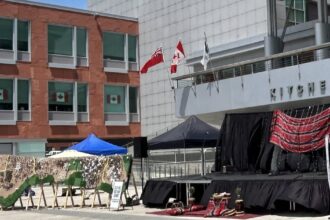In the coastal city of Saint John, New Brunswick, Dr. Ahmad Tabesh delicately maneuvers through the intricate chambers of a failing heart, his surgical precision giving a patient another chance at life. It’s a familiar scene for the Iranian-born cardiac surgeon, though his own journey to this operating room has been anything but routine.
“When I first arrived in Canada, I carried two suitcases and a dream,” Dr. Tabesh recalls, his voice steady as he adjusts his surgical mask. “One contained my medical books, the other held memories of home. The dream was to heal hearts in a country that would eventually become my own.”
Dr. Tabesh represents a growing demographic transformation in Saint John, where the immigrant population has surged dramatically over the past five years. According to recent Statistics Canada data, newcomers now account for approximately 7% of the city’s population, a significant increase from just 3.4% in 2016. This demographic shift has brought vital skills to the region’s healthcare system, with international medical graduates filling critical positions in specialized fields.
The New Brunswick Health Authority reports that international medical professionals now constitute nearly 28% of specialists in the province’s healthcare system, addressing severe shortages in cardiac care, neurology, and emergency medicine. Dr. Tabesh’s expertise in minimally invasive cardiac procedures has allowed the Saint John Regional Hospital to expand its treatment options for patients with complex heart conditions.
“In my first year here, I performed 118 cardiac surgeries,” Dr. Tabesh explains during a rare break between procedures. “Each operation connected me more deeply to this community. My patients don’t see me as a foreigner—they see someone who can help them.”
The journey from immigrant to established surgeon hasn’t been without challenges. Dr. Tabesh spent nearly three years navigating Canada’s medical credentialing system, completing additional training and examinations despite having practiced for fifteen years in Iran. The process is one familiar to many internationally trained medical professionals, who often face significant barriers to practicing in their fields.
“There were moments I questioned everything,” he admits. “But Saint John needed cardiac surgeons, and I needed a place where my family could build a future. Sometimes the most meaningful connections form from mutual necessity.”
Saint John’s economic revitalization efforts have included targeted immigration strategies through the Atlantic Immigration Program, which has successfully attracted skilled professionals to address critical labor shortages. Local business leaders and healthcare administrators have championed these initiatives, recognizing that population growth is essential to sustaining community services and economic prosperity.
City Councillor Donna Reardon emphasizes the community’s evolving perspective: “Ten years ago, there was resistance to change. Today, most residents understand that newcomers like Dr. Tabesh aren’t taking jobs—they’re filling crucial vacancies and creating opportunities that benefit everyone.”
The impact extends beyond the operating room. Dr. Tabesh has established a mentorship program for immigrant medical professionals navigating the Canadian healthcare system, helping others overcome the bureaucratic hurdles he once faced. His initiatives have received support from both provincial health authorities and community organizations dedicated to immigrant integration.
“Medicine transcends borders,” Dr. Tabesh reflects as he reviews a patient’s echocardiogram. “The heart functions the same way regardless of where you were born. What differs is access to care and opportunity.”
For the patients whose lives he’s saved, Dr. Tabesh’s background is secondary to his skill and compassion. Katherine MacMillan, a 73-year-old who underwent a complex valve replacement procedure, expresses what many in the community feel: “I don’t care where he came from—I care that he gave me more time with my grandchildren.”
As Saint John continues to evolve through demographic change, stories like Dr. Tabesh’s challenge conventional narratives about immigration and community identity. The surgeon who once arrived with two suitcases now carries something far more valuable: the trust of a community that has become home.
What remains to be seen is whether Canadian communities like Saint John will continue developing systems that more efficiently integrate international medical talent, or if skilled professionals will continue facing barriers that delay their contributions to communities in desperate need of their expertise?











